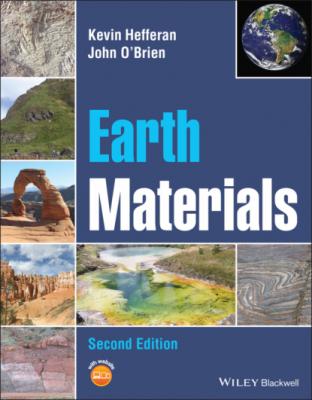Earth Materials. John O'Brien
Читать онлайн.| Название | Earth Materials |
|---|---|
| Автор произведения | John O'Brien |
| Жанр | География |
| Серия | |
| Издательство | География |
| Год выпуска | 0 |
| isbn | 9781119512219 |
Figure 2.19 Common coordination polyhedra: (a) cubic closest packing, (b) cubic, (c) octahedral, (d) tetrahedral, (e) triangular, (f) linear.
Source: Wenk and Bulakh (2004). © Cambridge University Press.
Table 2.6 Variations in ionic radius (in angstroms) with coordination number (CN) for some common cations.
| Ion | CN = 4 | CN = 6 | CN = 8 |
|---|---|---|---|
| Na+1 | 0.99 | 1.02 | 1.18 |
| K+1 | 1.38 | 1.51 | |
| Rb+1 | 1.52 | 1.61 | |
| Cs+1 | 1.67 | 1.74 | |
| Mg+2 | 0.57 | 0.72 | |
| Al+3 | 0.39 | 0.48 | |
| Si+4 | 0.26 | 0.40 | |
| P+5 | 0.17 | 0.38 | |
| S+6 | 0.12 | 0.29 |
2.5 THE CHEMICAL CLASSIFICATION OF MINERALS
The formation and growth of most minerals can be modeled by the attractive forces between cations and anions, the formation of coordination polyhedra with unsatisfied negative charges and the attraction of additional ions to build additional coordination polyhedra ad infinitum, until the conditions for growth cease to exist. It is useful to visualize minerals in terms of major anions and anion groups and/or radicals bonded to various cations that effectively neutralize their charge during the formation and growth of minerals. One common way to group or classify minerals is to do so in terms of the major anion group in the mineral structure. Those that contain (SiO4)−4 silica tetrahedra, discussed in the previous section, are silicate minerals, by far the most common minerals in Earth's crust and upper mantle. Those that do not contain silica tetrahedra are nonsilicate minerals and are further subdivided on the basis of their major anions. Table 2.7 summarizes the common mineral groups according to this classification system. These groups are discussed in more detail in Chapter 5.
Figure 2.20 A silica tetrahedron is formed when four oxygen ions (O−2) bond to one silicon ion (Si+4) in the form of a tetrahedron. The electrostatic valency of each silicon–oxygen bond in the silica tetrahedron is one charge unit, which fully neutralizes the charge on the central silicon ion (four = four), while leaving the charge on the oxygen ions only partially neutralized (one is one‐half of two).
Table 2.7 Mineral classification based on the major anion groups.
| Mineral group | Major anion groups | Mineral group | Major anion groups |
|---|---|---|---|
| Native elements | None | Nitrates | (NO3)−1 |
| Halides | F−1, Cl−1, Br−1 | Borates | (BO3)−3 and (BO4)−5 |
| Sulfides | S−2, S−4 | Sulfates | (SO4)−2 |
| Arsenides | As−2, As−3 | Phosphates | (PO4)−3 |
| Sulfarsendies | As−2 or As−3 and S−2 or S−4 | Chromates | (CrO4)−5 |
| Selenides | Se−2 | Arsenates | (AsO4)−3 |
| Tellurides | Te−2 | Vanadates | (VO4)−3 |
| Oxides | O−2 |
